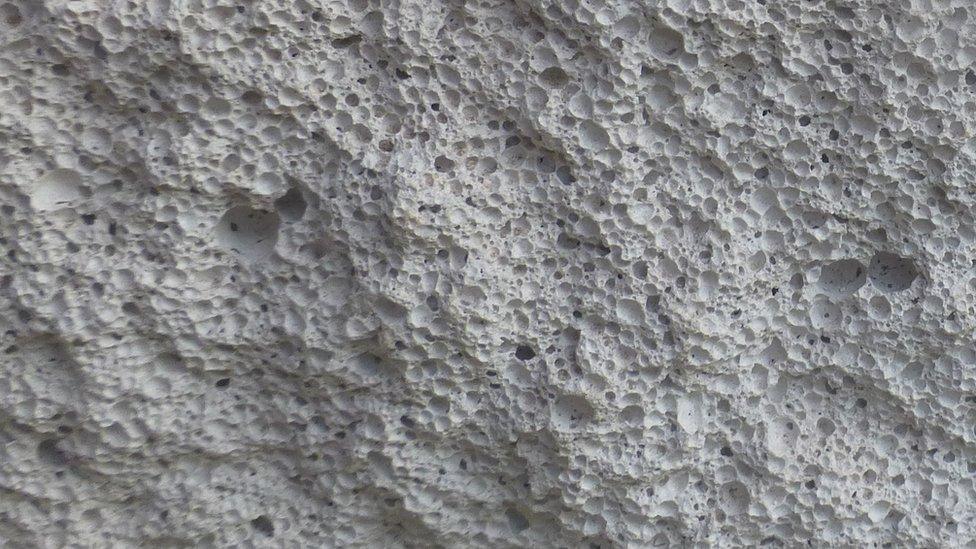Faulty concrete fears at 250 NHS Scotland sites
- Published
- comments

Buildings in Dundee's Ninewells Hospital are identified in the report
More than 250 NHS buildings in Scotland could contain a potentially dangerous type of concrete that can collapse without warning.
NHS Scotland issued a Safety Action Notice, external in February and completed a "desktop survey" of its estate in June.
Reinforced autoclaved aerated concrete (RAAC) was used to build roofs, walls and floors from the 1960s to the 1990s.
NHS Scotland has warned the material is potentially vulnerable to "catastrophic failure without warning".
But a Scottish government spokesperson said there was "no evidence to suggest that these buildings are not safe."
NHS Scotland's review identified 254 buildings that "have two or more characteristics which are consistent with the presence of RAAC".
Following the desktop survey, health officials began on-site investigations to determine whether RAAC is actually present. These are expected to take between six and eight months to complete.
The sites identified in the initial survey range from main ward hospital blocks to disused public toilets.
Major sites such as Ninewells Hospital in Dundee, University Hospital Crosshouse in Kilmarnock and the more recently constructed Queen Elizabeth University Hospital in Glasgow are named in the report as having buildings which could contain RAAC.
Any repairs are expected to come at a considerable cost.
NHS Grampian had the most buildings which could potentially contain RAAC, with 53 identified by the health board, followed by NHS Greater Glasgow and Clyde with 44 and NHS Lothian with 35.
NHS Highland identified 25 potentially affected buildings, while NHS Fife had 22. NHS Forth Valley reported eight and NHS Borders seven.
What is RAAC?

The lightweight concrete was widely used from the 1960s to the 1990s
The lightweight concrete was used in roofs, floors and walls between the 1950s and 1990s as a cheaper alternative to the standard building material.
It was widely used in public buildings and has been found in Scottish hospitals, schools and police stations.
RAAC has air bubbles inside of it and has a limited lifespan.
NHS Scotland warned in its Safety Action Notice that RAAC planks are considered to be "relatively weak and prone to degradation over time".
It added: "The limited visible exposure of panels to assess their condition may result in catastrophic failure without warning."
A Scottish government spokesperson said NHS Boards were required to regularly assess the condition of their property.
The spokesperson added: "The programme of activity planned for RAAC is in line with these requirements.
"Due to our absolute commitment to ensuring facilities are sound we have commissioned this exercise to better understand the position."
The alarm was first raised about the potential dangers of RAAC, also known as Siporex, in 2018 after the roof of a primary school in Kent suddenly gave way.
A leaked email sent to Downing Street from senior officials at the Department for Education in December said many school buildings now posed a "risk to life" as a result of the presence of crumbling concrete.
Pupils at two Edinburgh primary schools will be moved into temporary classrooms when the new term begins next month after RAAC was found in the roofs.
Children at Trinity and Cramond primaries will be taught in portable classroom units.
Four classes at Trinity Primary will move into makeshift classrooms being erected in the nearby Trinity Academy playground.
And at Cramond, two blocks each with two separate rooms and toilets will be sited on the netball pitch.
The makeshift units were previously used at Liberton Primary School after a fire caused significant damage to the building in 2020.
City of Edinburgh Council has not said when the remedial work will begin, but it has asked engineers to progress initial designs for the roof replacements.
Earlier this year, the council said 15 buildings it owned"may" contain the concrete mix and surveys are ongoing to determine if any others are at risk.
Joan Griffiths, education, children and families convener for Edinburgh Council, said: "The safety of all our young people and staff in our schools is paramount and the measures we have taken reinforce this position.
"As soon as this was confirmed we immediately put in place alternative learning and teaching arrangements at these schools for the small number of classes affected."
Other local authorities, including West Lothian Council, have already set out plans to spend millions replacing RAAC panels in schools.
Related topics
- Published25 May 2023

- Published5 July 2022
